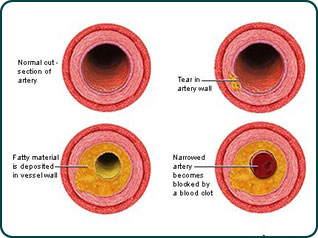Four Easy Ways to Keep Your Blood Healthier and to Prevent Heart Attacks
Cholesterol is fat in the blood

We all know the basics of heart attack prevention - but what about the blood?
We’ve been informed for years by health experts about the lifestyle changes we can make to help prevent heart attacks. I’m sure you already know about the following healthy practices that keep your heart healthy, and help you to maintain your general health:
- exercising
- eating a healthy diet
- reducing stress
- sleeping well
- not smoking
- not drinking too much alcohol
- being aware of your family history
- regular screening
But why don’t health experts talk about the consistency of our blood? We’re told about the habits we need to change to fight heart disease, we’re shown diagrams of hearts and of arteries that are clogged with plaque and we’re reminded to keep our bad cholesterol down.
However, while health experts talk about our cholesterol, they seldom actually talk about it as fat flowing along with our blood. Sometimes they seem so shy about mentioning blood that they sound as if they think the public can’t handle the word. I can understand people not being able to handle the idea of someone bleeding. But keeping our circulating blood healthy within our bodies should not be a taboo subject.
If we didn’t have blood, how would that bad stuff get to our arteries to clog them? If blood wasn’t flowing through our arteries we wouldn’t have anything to carry the fat and stress hormones to them. As we don’t have the option of emptying ourselves of blood (as least not a desirable option), we need to watch the condition of our blood.
To that end, maintaining a healthy bloodstream is important in preventing heart disease, and we need to think about what goes into it.
You can actually see fat in your blood
The first thing we can do is visualize what our blood supply contains when we eat fatty foods. After you watch the video below, you’ll have a better understanding of the importance of fat in blood. (Don’t be concerned, it’s only before and after test tubes – no animal slaughter or surgeries.)
You can see the fat in your blood
I’ve found that when I visualize my blood before and after a fatty meal as I’m thinking about what to eat, I choose fatty foods less often. It has helped me to lessen the amount of fatty foods without thinking about giving them up as a lifestyle change that I don’t really want to make.
Blood flows better when you drink water
The next thing we can do to improve our blood is to drink plenty of water and other non-dehydrating fluids. The thickness of the blood affects how easily it passes through the bloodstream – and what fat it carries to the liver to break down instead of being left behind in the arteries. That’s the difference between water with a little mud in it and mud with a little water in it. Which consistency would you rather have in your arteries.
When we brush our teeth in the morning, most of us rinse our mouths and walk away from the sink. I’ve started following the mouth rinse by drinking a full glass of water. Your mouth feels fresh, even pepperminty and it’s a good time to have a glass of water, even if you don’t like water. Why drink that water?
Most heart attacks happen during the late morning, and during the time that we’re away from home. One of the reasons is that we tend not to keep ourselves as hydrated when we’re busy and away from home. Another reason is that we’ve become a society that drinks more dehydrating fluids than hydrating fluids.
If you’re drinking mostly caffeinated drinks or sugary drinks – or both – you’re drinking mostly dehydrating fluids. So drinking more water is helpful. You can drink more water by adding some flavor to it so it’s more enjoyable to drink. A little lemon or orange juice added to the water tastes good and would be good for you. Or you can put a breath freshener in your mouth and tuck it in your cheek while you drink water, for a fresh minty taste. I especially like to have ice water that way.
Medication isn't the only answer
You may be thinking that using medication to make your blood thinner is desirable. While an aspirin is generally a good addition for your daily routine for both thinning the blood and reducing minor inflammation all over the body, remember that aspirin or any other medication as a blood thinner is not a natural part of what the body recognizes when its doing fluid balancing.
For example, if you’re taking aspirin, you need to make sure that it doesn’t interact badly with any of your prescriptions. If you’re taking both aspirin and vitamin E, you are very probably thinning your blood to a point that you could be increasing your risk of stroke. Your body doesn’t balance that out by producing more clotting factor to counterbalance the aspirin and other thinning agents. So working with your body and your blood instead of taking medication to keep it in balance is a better solution.
Keeping your arteries flexible means keeping them stronger
Another easy habit keeps your arteries more flexible. You can accomplish this by simply stretching for about 10 minutes sometime during the day. If you can’t find 10 minutes at one time to stretch, do a stretch or two at different times throughout the day. Ten minutes of stretching is not only good for our muscles – we have fewer accidents when we’re more flexible - but it’s good for keeping our arteries in good condition.
We don’t think of our cardiovascular system when we exercise except in terms of aerobic or non-aerobic exercise. However, our arteries need more than blood pumping through them at various increased rates. They need the stiffness stretched out of them just our the muscles do. If we ignore that stretching, we aren’t allowing our arteries to maintain the flexibility to have strong, cohesive walls as we move or have stress, with the different rates of heartbeat and blood pressure that go along with our daily lives.
Don’t let the pressure in your tubes get too high
Keeping an eye on your blood pressure is as much a part of staying healthy as any other thing you do. If your blood pressure is too high, then you have a higher risk of both a heart attack and a stroke.
To understand your blood pressure, the higher number (the one on top) is called the systolic pressure, the blood pressure as the heart muscle contracts (as the heart beats). The lower number (the one always reported on the bottom) is called the diastolic pressure, the blood pressure in the arteries between beats, while the heart is resting and filling with blood.
A normal blood pressure is less than 120 over 80. You may occasionally go over that reading, but your normal reading should not be over 120-80. I’ve found that during times when I’m highly stressed, sick or sleepless for some reason, my blood pressure may temporarily go up to what’s called the prehypertensive range, which is 120-139 over 80-89. But it should not be in that range all of the time. And anything over the prehypertensive range is high blood pressure – a real no-no.
While stretching your body helps the arteries maintain their flexibility, high blood pressure against the arteries hurts them and makes them harden. Hardened arteries are weakened arteries, and the lack of flexibility in them makes the heart have to work harder to pump the blood. So over time it also weakens the heart.
Most basic, even digital, blood pressure monitors cost less than 15 dollars. When buying digital blood pressure monitors that have extra features, the cost can increase depending on what the desired features are. Many of the digital monitors are so easy to use that you simply put the cuff on your wrist or upper arm and a press a button, and it pumps itself up until it’s tight on your arm. Then the digital readout provides your blood pressure. Blood pressure cuffs are very quick and easy now. If you don’t feel confident about using it, you can go to any pharmacy and they’ll show you how to use a blood pressure monitor.
Blood pressure monitors that don't need batteries
How to easily reduce your blood pressure
One daily action that is very effective in reducing the blood pressure is reducing your salt intake. I know this can be a tough one, because even though I don’t eat fast food, I’ve been a salt lover all of my life. However, I’ve learned to satisfy most of my salt preference by using other herbs for flavoring.
An especially helpful combination that I use is lemon juice, grated lemon rind and more spicy herbs like a good black pepper or a smoky cardamom. While I don’t care for really hot peppers, many people also use cayenne, paprika and other hot pepper flavors as substitutes for salty flavor.
If you think about it, salt has a bite to it, and it enhances flavor, so if you want that bite, think of other alternatives you like, and think in terms of savory herbs to add as well to enhance flavor. If you also take a minute to measure your salt and very gradually lower the amount you use, reducing your salt intake won’t be as noticeable.
How does salt harm you when your blood pressure is tending to increase? Your body needs to keep a balance between the amount of salt it contains and the amount of other minerals. If you have eaten more salt than your body can properly handle, the extra salt makes you “hold water”, or keep water in your tissues instead of keeping it in your blood where it can be eliminated. Your kidneys try to maintain balance, but fingers, toes and ankles swell because salt is a mineral that makes water transfer from blood to tissues.
So you can have thicker blood and swollen tissues at the same time; the combination does nothing to help blood flow. It’s so much better to avoid the harm that a high salt diet can do to the fluid balance in your tissues, to the fluidity of your blood and, through higher blood pressure, to the health of your arteries.
Make some of all of the changes to prevent heart attacks
So, these small steps can make a big difference in your health:
- Be aware that the blood is the traffic stream that moves fat from fatty foods around your body, and some of that fat stays in your arteries.
- Keep yourself hydrated with fluids to keep your blood flowing well.
- Stretch for 10 minutes a day to keep your arteries flexible so your blood moves as it should.
- Gradually reduce your salt intake to help your blood pressure remain in the normal range
You may choose to do all of them or only one or two. Either way, you will benefit by making some simple changes in your daily routine.









